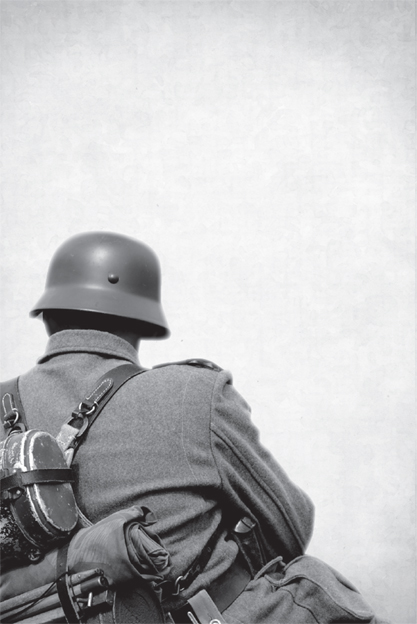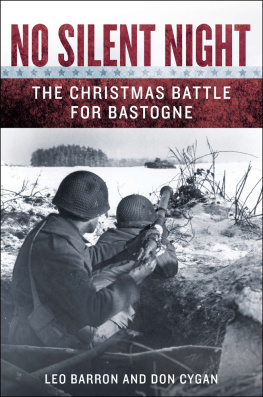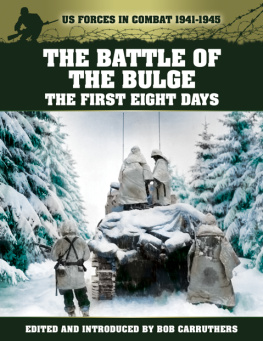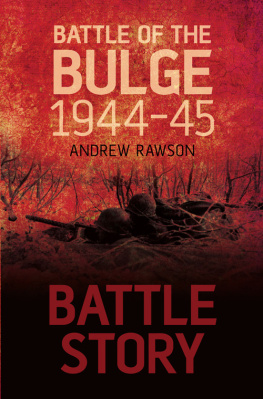NO SILENT NIGHT


NO SILENT NIGHT

THE CHRISTMAS BATTLE
FOR BASTOGNE
Leo Barron and Don Cygan

NAL C ALIBER
Published by New American Library, a division of
Penguin Group (USA) Inc., 375 Hudson Street, New York, New York 10014, USA
Penguin Group (Canada), 90 Eglinton Avenue East, Suite 700, Toronto, Ontario M4P 2Y3, Canada (a division of Pearson Penguin Canada Inc.)
Penguin Books Ltd., 80 Strand, London WC2R 0RL, England
Penguin Ireland, 25 St. Stephens Green, Dublin 2, Ireland (a division of Penguin Books Ltd.)
Penguin Group (Australia), 250 Camberwell Road, Camberwell, Victoria 3124, Australia (a division of Pearson Australia Group Pty. Ltd.)
Penguin Books India Pvt. Ltd., 11 Community Centre, Panchsheel Park, New Delhi - 110 017, India
Penguin Group (NZ), 67 Apollo Drive, Rosedale, Auckland 0632, New Zealand (a division of Pearson New Zealand Ltd.)
Penguin Books (South Africa) (Pty.) Ltd., 24 Sturdee Avenue, Rosebank, Johannesburg 2196, South Africa
Penguin Books Ltd., Registered Offices:
80 Strand, London WC2R 0RL, England
First published by NAL Caliber, an imprint of New American Library, a division of Penguin Group (USA) Inc.
First Printing, November 2012
10 9 8 7 6 5 4 3 2 1
Copyright Leo Barron and Don Cygan, 2012
Maps by Chris Erichsen
All rights reserved. No part of this book may be reproduced, scanned, or distributed in any printed or electronic form without permission. Please do not participate in or encourage piracy of copyrighted materials in violation of the authors rights. Purchase only authorized editions.
NAL CALIBER and the C logo are trademarks of Penguin Group (USA) Inc.
LIBRARY OF CONGRESS CATALOGING-IN-PUBLICATION DATA:
Barron, Leo.
No silent night: the Christmas battle for Bastogne/Leo Barron and Don Cygan.
p. cm.
Includes bibliographical references and index.
ISBN: 978-1-101-60273-7
1. World War, 1939-1945CampaignsBelgiumBastogne. 2. Ardennes, Battle of the, 1944-1945. I. Cygan, Don. II. Title.
D756.5.A7B257 2012
940.54219348dc23 2012007136
Set in Granjon
Designed by Patrice Sheridan
Printed in the United States of America
PUBLISHERS NOTE
While the author has made every effort to provide accurate telephone numbers, Internet addresses and other contact information at the time of publication, neither the publisher nor the author assumes any responsibility for errors, or for changes that occur after publication. Further, publisher does not have any control over and does not assume any responsibility for author or third-party Web sites or their content.

Mge die Welt nie mehr solche Weihnachtsnacht erleben! Nichts ist schrecklicher, als fern von Mutter, Frau und Kinder, von Waffen niedergerestrckt zu werden. Entspricht es der Menschenwrde, der Mutter, einen Sohn zu rauben, der Gattin den Ehmann, den Kindern ihren Vater? Das Leben wird uns geschenkt, um einander zu lieben en zu achten. Aus den Ruinen, dem Blut und dem Tode wird wohl eine bruderlisch Welt geboren werden.
Ein Deutscher Offizier
Let the world never see such a Christmas night again! To die, far from ones children, ones wife and mother, under the fire of guns, there is no greater cruelty. To take away a son from his mother, a husband from his wife, a father from his children, is it worthy of a human being? Life can only be for love and respect. At the sight of ruins, of blood and death, universal fraternity will rise.
Discovered by schoolmaster Monsieur Schmitz and several Americans written on a chalkboard at the local school in Champs, Belgium, after the Christmas Day battle. The author was likely a German officer from the 77th Volksgrenadier Regiment.
To Carl Koonsman, a teacher who sparked my interest in World War II
DON CYGAN
To Blake Russell and all the other Screaming Eagles who
made the ultimate sacrifice
LEO BARRON
ACKNOWLEDGMENTS
In writing this book, the authors compiled and reviewed extensive archival data, letters, written accounts, photographs, and maps from a vast number of sources. Both authors, veterans of the U.S. Army, walked the battle sites and conducted multiple simulations and field tests to help understand all the aspects of what transpired during the Christmas Day battle. Many interviews were conducted with noted survivors of the struggle.
First and foremost, this story is about the battalions that fought in the Christmas Day battle. Therefore, most of our attention focuses on the 1/401st Glider Infantry, 1/502nd Parachute Infantry, elements of the 705th Tank Destroyer Battalion, the 463rd Parachute Field Artillery Battalion, and the 406th Fighter Group. On the German side, we highlight the contributions of the 77th Volksgrenadier Regiment and the 115th Panzergrenadier Regiment. We also spend a great deal of time on the commanders who made the crucial decisions: Oberst Heinz Kokott, General der Panzertruppen Heinrich von Lttwitz, Brigadier General Anthony McAuliffe, Lieutenant Colonel Steve Chappuis, Lieutenant Colonel John Cooper, Lieutenant Colonel Ray Allen, and Oberst Wolfgang Maucke.
We decided to tell the story of No Silent Night in as close to a narrative style as possible, as seen through the eyes of the participants, but grounded in this historical research. In several points in the book (primarily dialogue where actual quoted conversations were not available, or the actual account was brief and dry), we took the liberty of creating conversations or thought processes based on transcripts, notes, or accounts of what was said or doneparticularly during some of the command briefings. Notes taken at these briefings were often written without elaboration, but when we compared the information from other sources, certain logical deductions could be made and constructed to create a more complete picture for the reader. In other words, we know what was discussed at these meetings, and we know what documents were produced as a result of what was discussed at these meetings. Therefore, we can infer from these primary sources the thought process involved. As a result, instead of presenting a dry and boring account of what was said, we decided to make it more engaging by presenting them as conversations between the participants. Do we know the exact words that were said? No. But the substance of the conversations is accurate, according to the historical record. An example of this would be the operations briefing for the German plan for the Ardennes offensive. Colonel Heinz Kokott, who was the commander of the 26th Volksgrenadier Division, attended the briefing in Kyllburg. We know that for a fact. We also know who else was there, thanks to Kokotts notes and those of others. Finally, we know what was discussed due to subsequent interviews with Kokott and his commander, General Heinrich Freiherr von Lttwitz. To flesh out the operations briefing, we quoted from the operational ordernamed Christrose. Therefore, the staff officers words are actually the contents of the order. The result is a balanced snapshot of the briefing: one that provides the reader context as well as the actual information from German records.



















